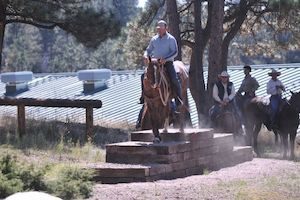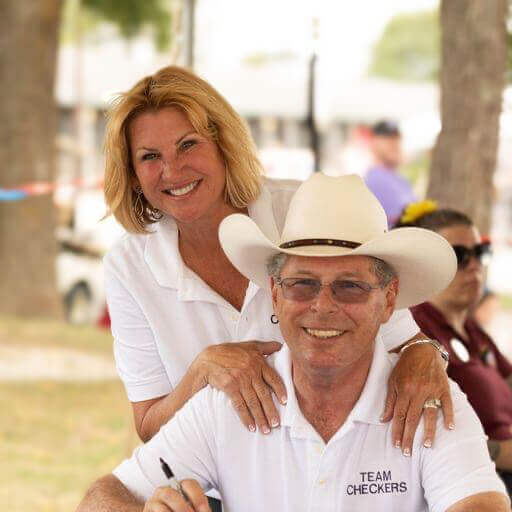Reduce Injuries with Skills, Training, and Common Sense
by Mark Bolender

Mountain Trail has its hazards and there is potential for injury in many areas. We trainers and riders have an obligation to protect our horses to the best of our ability.
Over the years I’ve noticed some riders go for years without sustaining any serious injuries to their horses, while other riders seem to have horses that are constantly getting hurt. I’ve noticed a common reason why this one group of horsemen seems to have fewer problems. Now, all of us understand that a horse can be injured suddenly and accidentally and no one is to blame. I am talking about lowering the odds that your horse will sustain injuries while training or competing in Mountain Trail.
The horsemen with the lowest odds of sustaining injury to their horses are the ones that have “broke” horses. This sounds obvious, but a broke horse and a good rider have more tools to deal with in an adverse situation and the skills needed to navigate a new obstacle.
So how do riders get the skills to lower their risk of injury? What should be their priorities for safety? The following points are my checklist of what’s needed.
- First go back to the basics of walking, trotting and canterloping (canter or lope) a straight line. Set up a line of eight sets of cones covering a distance of at least 80 feet. Navigating this sounds simple, but we find only one in ten can ride a straight line at our clinics. Everyone laughs when I bring out the cones, but it’s always the same. The way to ride a straight line is to focus forward and use your legs and seat. Most try to ride the face, and it will always be a crooked line.
- The next exercise is to ride a 20-meter circle through cones that are set 36 inches apart. Again, the way to be successful is to look ahead and not down at the set of cones you are riding through. You always look ahead one set of cones and then you can ride a nice circle.
- Work on your transitions until you can go from a trot to a walk at any given point. If you ask for a walk but it takes 20 feet to get it, you are not ready to move up to the canterlope. In level II of Mountain Trail you must trot between obstacles. Therefore, you must be able to transition to the walk at the obstacle. If you can’t manage this, you are risking injury to your horse (and yourself.) In level III you must be able to transition down to a walk from a canterlope at the obstacle. Obviously, this means you need to have the skill to transition down in an arena before you attempt this on the course.
- Make sure you have a soft correct backup. It is surprising how many do not have this skill, and when they need it, the horse and rider become frustrated and often put themselves and their horses in danger. If you do not have this skill find a professional to help—it’s critical.
- Be able to move the haunches and shoulders easily; this gives you a nice leg yield.
- Protect your horse with leg wraps.
- Have the wisdom to avoid what appear to be unsafe or poorly constructed obstacles. With the growth of trail obstacle training and competitions there are many obstacles that are very unsafe. Some people see obstacles on the internet and attempt to copy designs without understanding the engineering that is hidden within the obstacle. The refinement of the sport has brought many improvements in the obstacles. The structural qualities have been increased with safety always the priority. The dream of a ribbon is not worth taking the risk of navigating an obstacle that may fail and cause injury.
- Make sure your horse can stand still! Train this and you will end up with a quiet horse who is a joy to be around. It is easy to teach but often not done because few people take time to just sit and enjoy the horse.
I am sure there are many other skills that good horsemen possess, but these are the highest priority to me. Well-trained horses are the most fun and have fewer injuries.
Happy Trails and Bolender Blessings.
Originally Published October 2017 Issue

Mark and Lee Bolender own and operate Bolender Horse Park in Washington State, which houses the finest Mountain Trail course in the world. They are the founders of the International Mountain Trail Challenge Association (IMTCA) and travel worldwide as clinicians and ambassadors of Mountain Trail. Bolender Horse Park offers riders of all skill levels and disciplines a fun and challenging trail riding adventure.
Mark has designed and built Mountain Trail courses in the USA, Canada, Australia, and Europe—with many more in development. Mark uses his artistic, landscaping, horse training, and construction skills to build these courses (NW Steel Design LLC www.nwsteeldesign.com).
Mark is the author of Bolender’s Guide to Mastering Mountain and Extreme Trail Riding. Visit www.bolenderhorsepark.com to learn more.






